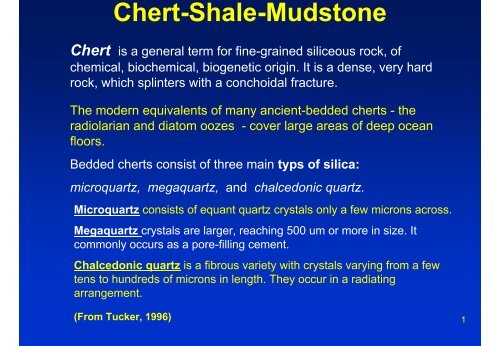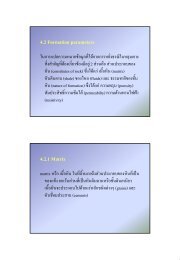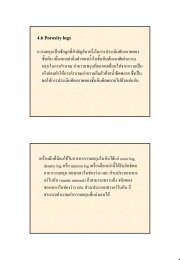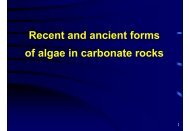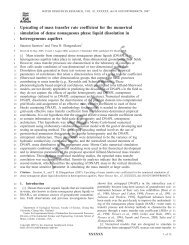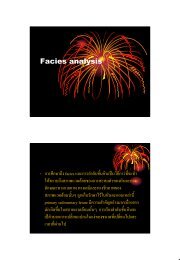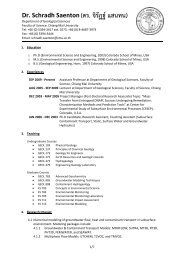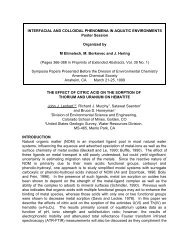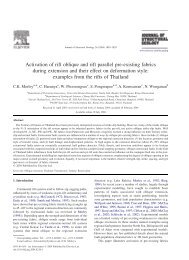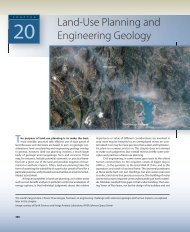Chert-Shale-Mudstone
Chert-Shale-Mudstone
Chert-Shale-Mudstone
You also want an ePaper? Increase the reach of your titles
YUMPU automatically turns print PDFs into web optimized ePapers that Google loves.
<strong>Chert</strong>-<strong>Shale</strong>-<strong>Mudstone</strong><strong>Chert</strong> is a general term for fine-grained siliceous rock, ofchemical, biochemical, biogenetic origin. It is a dense, very hardrock, which splinters with a conchoidal fracture.The modern equivalents of many ancient-bedded cherts - theradiolarian and diatom oozes - cover large areas of deep oceanfloors.Bedded cherts consist of three main typs of silica:microquartz, megaquartz, and chalcedonic quartz.Microquartz consists of equant quartz crystals only a few microns across.Megaquartz crystals are larger, reaching 500 um or more in size. Itcommonly occurs as a pore-filling cement.Chalcedonic quartz is a fibrous variety with crystals varying from a fewtens to hundreds of microns in length. They occur in a radiatingarrangement.(From Tucker, 1996)1
Scanning electron micrographs of radiolariansRadiolarians aremarine zooplanktonwith a range ofCambrian to Recent.They have duscshaped,elongate andspherical tests withspines and surfaceornamentation.They range in sizefrom a few tens tohundreds of microns.(From Tucker, 1996)The radiolarians in thispicture are from theUpper Cretaceous ofCyprus.2
Microquartz, megaquartz and chalcedonic quartzMicroquartzChalcedonic quartzMegaquartzChalcedonic quartzin spherulitic growthstructure(From Tucker, 1996)3
Radiolarian chertPlane-polaized lightCrossed polarsThe sample shows the spherical radiolarian tests and a few thinspines set in a matrix masked by red-brown iron oxide.From MacKenzie and Adams, 19944
Replacement chertPlaine -polarlized lightCrossed polarsMany cherts are secondary, usually replacing limestone. Replacementis often partial, silica preferentially picking out certain shell fragments.The pictures show a chert from a layer within a carbonate sequence.The limestone before replacement consists of peloids, ooids and shellfragments. Most of the original grains have been replaced bymicroquartz.(From MacKenzie and Adams, 1994)5
MudrockThe term Mudock refers to all siliciclastic sedimentary rockscomposed of silt-sized and clay sized particles. Mudrock includes twolithologies…. siltstone and claystone.<strong>Mudstone</strong> is indurated mud, which is a mixture of silt with betweenone-third and two-thirds clays.<strong>Shale</strong> is any mudrock that exhibits lamination or fissilityArgillite is mudrock that has been subjected to low-grademetamorphism.(From Prothero and Schwab, 1996)6
<strong>Shale</strong>Well-developed fissility in theAmtrim <strong>Shale</strong> (Mississippian),Michigan, USA.(From Prothero and Schwab, 1996)7
<strong>Shale</strong> and <strong>Mudstone</strong>Fissile black, organic-rich shale.Kimmeridge Clay, Jurassic.Yorkshire, England.Massive, non-laminatedmudstone with concoidalfracture. Lower Carboniferous.Wales, UK.(From Tucker, 1996)8
Lamination in <strong>Mudstone</strong>A, Rhythmitesconsisting of gradedsilt passing up intoclay-grade material.Late Precambrian.B, Rhythmitesconsisting ofalternations of silt-gradequartz and clay-organicmatter.Middle Devonian.(From Tucker, 1996)9
Laminated mudstoneLaminated mudstone shows subangular silt-grade quartz, muscoviteflakes oriented parallel to lamination and organic-clay laminar (dark).Plane-polarized light. (From Tucker, 1996)10
Laminated mudstone and carbonaceous shaleABA, Laminated dark grey toblack mudstone consisting siltinterstratified with dark shale.B, <strong>Shale</strong>, showing severalbeds of carbonaceous shalealternating with graded siltmudcoupletsFrom Blatt and Tracy, 199611
Photomicrographs of bituminous coalThe pictures showvaious macerals.LiptiniteVitriniteInertinite1. Liptinite2. Vitrinite3. Inertinite(From Tucker, 1996)Liptinite has a low reflectance and so forms the darkest areas.Vitrinite has medium reflectance and so appears medium grey.Inertinite has a high reflectance and so has a very bright, light-greyappearance.12
Photomicrograph of a coal ballThe coal balls are early diagenetic nodules which formed beforecompaction and alteration of the organic matter. These arecomposed of calcite or dolomite and well - preserved plant material.In this Carboniferous coal ball, fragments of the large trees areabundant. This indicates that the coal was derived from peat offorest-swamp environment (From Tucker, 1996).13
The End14


